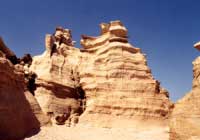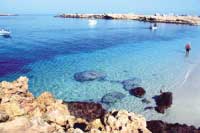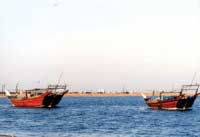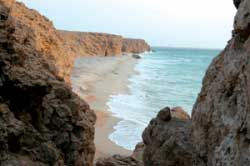Ras al Hadd is the place to visit with families and children during July-October when more than 50,000 turtles land in there to lay eggs and return and is part of the Wilayat of Sur. It overlooks the sea and it is a natural harbour for sailing ships.
Ras al Hadd offers exciting opportunities for camping, bird watching, fishing, games, and a wide variety of other recreational activities. Known for clean, largely untouched and unexplored beaches with a very high environmental quality, Ras al Hadd is also a very important historical place with some findings that date back to the third and fourth hundred BC.
Marine turtles form a prominent part of the fauna of the Ras al Hadd, which contains some globally important nesting beaches. Green turtles are the most commonly seen turtles in Oman, and nest on more than 275 beaches spread along the entire coast. An estimated 50,000 to 60,000 green turtle egg clutches are laid each year in the Sultanate, the effort of about 20,000 turtles or more. This gives Oman probably the greatest number of nesting green turtles of any single Indian Ocean nation.
The most important part of the region for turtles is the Ras al Hadd, both in terms of number of breeding species and abundance of individuals. The
 weather is generally pleasant at Ras al Hadd;
it is neither very cold nor hot. The sea is calm and winds are
normal. There are ample provisions for boating and fishing. Not
only this, but the tourist can go boating, do fishing and bring
their catch home.
weather is generally pleasant at Ras al Hadd;
it is neither very cold nor hot. The sea is calm and winds are
normal. There are ample provisions for boating and fishing. Not
only this, but the tourist can go boating, do fishing and bring
their catch home.Other easily accessible and equally attractive tourist spots in the eastern region that tourists in Ras al Hadd can visit are Sur, Al Kamil W’al Wafi, Al Ashkara, Sharqiyah Sands, Jaalan Bani Bu Hassan, and Jaalan Bani Bu Ali. Eco-tourism, generally characterised by travel to a natural area that supports the conservation of biodiversity, is what one finds in Ras al Hadd. Marine Eco-tourism, as in the case of Ras al Hadd, provides economic and social incentives for promoting conservation of the important ecosystems, mainly the coral reefs and turtle nesting sites.
Tour operators say Ras al Hadd is one of Oman’s most attractive areas. Oman’s resources like wadis, beaches, forts, castles, and natural beauty and scenery, including the local culture are its strengths. This area is known for a wealth of natural beauty and scenery. A number of other scenic spots are easily accessible from Ras al Hadd. The Ras al Hadd area is one of the few places in the Sultanate where tourism thrives even in the summer because it’s cool by virtue of being near the sea.
Being the easternmost end of the Arabian Peninsula, Ras al Hadd offers a breathtaking view of the first sunrise in the region. It is also a nature reserve of the Sultanate because of the thousands of green turtles that come ashore every year for laying eggs. Ras al Hadd offers travellers a unique holiday experience. The combination of Sun, Sand and Sea makes for superb beach holidays here.
The local people welcome here tourists with open arms, displaying age-old traditions of Arabian hospitality. Add to this, a pleasant climate, excellent water sports, leisure facilities, uncrowded beaches, spectacular desert and mountain scenery and you get a perfect place for picnic. The Ras al Hadd coast, edged by wide sandy beaches, is home to over 8,000 people. Fisheries are the dominant source of income for the people.
The town, set against its spectacular mountain backdrop, is known for several important historical places, archaeological sites and marine flora and fauna. There is much to see throughout Ras al Hadd. The town’s history can be explored in its ancient towns, watchtowers and mosques.
A 400-year-old Ras al Hadd Fort stands overlooking the sea. Renovated in 1989, it tells a lot about ancient Oman. It has three towers and a large courtyard and was built in a period of 10 years. Its construction was aimed at watching the incoming ships and to defend the citizens from any eventuality. Inside the fort there is a dark chamber, showing the opening of a 500 metre long tunnel. This tunnel used to be of utmost significance for bringing food
 and other requirements during times of crisis.
and other requirements during times of crisis.Nestling under the cliffs away from the sea is an archaeological site where excavations have discovered the remains of small settlements, dating back to 600 BC. Among the most notable discoveries were a number of stamps, made of local stones and related to the Arabic calligraphy known as Majnubi, the oldest known calligraphic style in the Arabian Peninsula.
Ras al Hadd in general and Al Sharqiyah region in particular offers something for everyone. Historians and archaeologists will find remnants of civilisations that go back to the beginning of recorded history. Photography buffs will find a picture-postcard shot almost everywhere they turn.
Explorers will discover an ancient boat building yard. The region is sprinkled with castles, fortresses, defence towers and mosques. Amazing rock formations, minerals and fossils will delight amateur geologists. Eco-tourists will find a dramatic change in scenery in Ras al Hadd and other towns in its vicinity.
Green turtles: This eastern Sharqiyah region endowed with a spectacular coast steeped in antiquity is abuzz with the annual fertility rite of Green turtles. During May to July, the Green turtles swim closer to Omani waters for feeding and mating. The July-September period marks the peak season for mating and nesting while from September to November, the survival saga of hatchlings unravels on the pristine sandy beaches.
The 42-km stretch of beaches comprising the Ras al Hadd Turtle Reserve is a safe haven for Green turtles. In the dead of night, female turtles weighing an average 150 kg swim ashore for nesting. Up to 100 of them converge every night at Ras al Jinz, which is the only beach where visitors
 are allowed to view the
nesting process.
are allowed to view the
nesting process.There are many green turtles that visit these areas, especially 15 beaches bordered with rocky cliffs, which are not monitored in view of the rough sea. These beaches serve as naturally protected areas for nesting turtles. The September-January period is the best time for visitors to watch the nesting process. The weather is very pleasant at this time due to the influence of the monsoon season and the visit of turtles are also above average levels.
After laying eggs in the sandy nest, the turtles deftly cover the nest and proceed ahead to make a larger hole, which is mistaken by predators as the nest with eggs. On an average, a green turtle lays a clutch of 100 eggs.
For millions of years, Sharqiyah’s picture perfect beaches bordered by sculpted mountains have been a safe habitat for nesting Green turtles. For 90 million years, turtles roamed freely the world’s oceans and swam ashore to nesting beaches.
A 330-km drive from Muscat takes you to Sur, the capital of Sharqiyah region. Another 65 km takes you to the turtle nesting beach in Ras al Jinz and Ras al Hadd.





 The
beaches extending from Ras Al Hadd to Masirah Island in the A'Sharqiyah
Region are considered a turtle reserve, including the green turtle,
which is a rare turtle that returns every year to lay its eggs on the
same beach where it was born decades ago. Ras Al Jins is a quiet
sanctuary for turtles where they lay their eggs, securing the continued
survival of the species and protecting them from extinction. Apart from
the turtle breeding season (which extends throughout the year in varying
degrees), you can enjoy the beauty of the beach and view the magnificent
tracks left by the turtles. A scientific centre has been established
containing illustrative displays of the turtles laying their eggs. The
reserve is 65 kilometers east of Sur City and can be reached through Al
`Ayjah village. To visit the Reserve, you must book in advance with the
Turtle reserve Management Company in Ras Al Jins at the following email
address:
The
beaches extending from Ras Al Hadd to Masirah Island in the A'Sharqiyah
Region are considered a turtle reserve, including the green turtle,
which is a rare turtle that returns every year to lay its eggs on the
same beach where it was born decades ago. Ras Al Jins is a quiet
sanctuary for turtles where they lay their eggs, securing the continued
survival of the species and protecting them from extinction. Apart from
the turtle breeding season (which extends throughout the year in varying
degrees), you can enjoy the beauty of the beach and view the magnificent
tracks left by the turtles. A scientific centre has been established
containing illustrative displays of the turtles laying their eggs. The
reserve is 65 kilometers east of Sur City and can be reached through Al
`Ayjah village. To visit the Reserve, you must book in advance with the
Turtle reserve Management Company in Ras Al Jins at the following email
address: